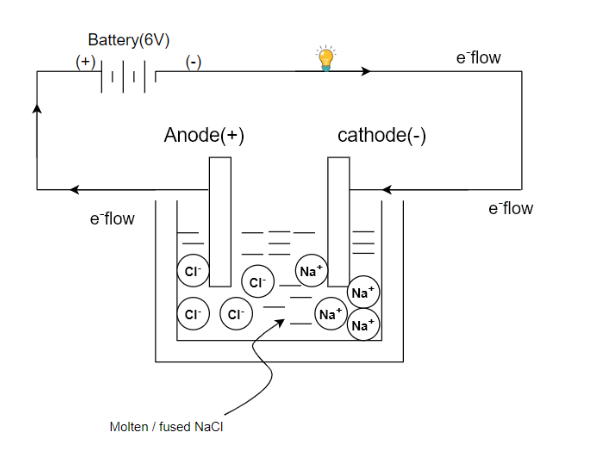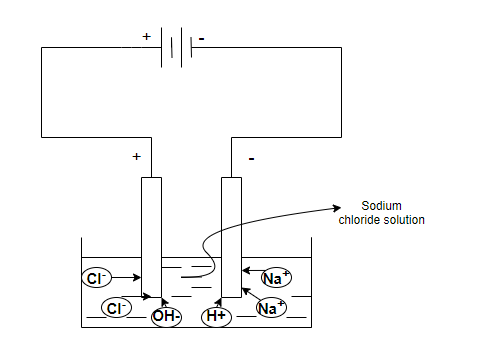
Answer
488.1k+ views
Hint- In order to solve this question, firstly we will understand the concept of electrolysis of sodium chloride. Then we will understand the two methods of electrolysis involving molten sodium chloride and aqueous sodium chloride to get the required answer.
Step By Step Solution :
Electrolysis is a technique for isolating bonded elements and compounds by passing an electric current through them. Electrolysis is significant industrially as a phase in the separation of elements from normally occurring sources, for example, ores, using an electrolytic cell.
Electrolysis of sodium chloride-
Two generally utilized techniques for electrolysis include molten sodium chloride and aqueous sodium chloride, which give various items. As we realize that the electrolysis is the going through of an immediate electric current through an ionic substance that is either molten or dissolved in a suitable solvent.
1.) Electrolysis of Molten sodium chloride-

In the event that the NaCl is melted, two electrodes are embedded into the molten, and an electric current is passed through the molten salt, at that point chemical reactions occur at the electrodes.
Sodium ions move towards the cathode, where electrons come into the melt and get reduced to sodium metal, chlorine ions move towards the anode. They give up their electrons to the anode and are oxidized to chlorine gas.
The chemical reaction-
$2NaCl \to 2Na(s) + C{l_2}(g)$
2.) Electrolysis of aqueous sodium chloride-

Electrolysis of aqueous sodium chloride results in hydrogen and chloride gas. At the anode, $C{l^ - }$is oxidised to chlorine. The ion-selective membrane allows the Na+ to freely flow across. At the cathode, water is reduced to hydroxide and hydrogen gas.
The chemical reaction-
$NaCl(aq) + {H_2}O(l) \to N{a^ + }(aq) + O{H^ - }(aq) + {H_2}(g) + \dfrac{1}{2}C{l_2}(g)$
Hence, option A is correct.
Note: While solving this question, we must know that the process of electrolysis of an aqueous solution of NaCl gives industrial useful products which are sodium hydroxide (NaOH) and chlorine gas. Also one must know that reduction of Na+ is energetically more difficult than the reduction of water.
Step By Step Solution :
Electrolysis is a technique for isolating bonded elements and compounds by passing an electric current through them. Electrolysis is significant industrially as a phase in the separation of elements from normally occurring sources, for example, ores, using an electrolytic cell.
Electrolysis of sodium chloride-
Two generally utilized techniques for electrolysis include molten sodium chloride and aqueous sodium chloride, which give various items. As we realize that the electrolysis is the going through of an immediate electric current through an ionic substance that is either molten or dissolved in a suitable solvent.
1.) Electrolysis of Molten sodium chloride-

In the event that the NaCl is melted, two electrodes are embedded into the molten, and an electric current is passed through the molten salt, at that point chemical reactions occur at the electrodes.
Sodium ions move towards the cathode, where electrons come into the melt and get reduced to sodium metal, chlorine ions move towards the anode. They give up their electrons to the anode and are oxidized to chlorine gas.
The chemical reaction-
$2NaCl \to 2Na(s) + C{l_2}(g)$
2.) Electrolysis of aqueous sodium chloride-

Electrolysis of aqueous sodium chloride results in hydrogen and chloride gas. At the anode, $C{l^ - }$is oxidised to chlorine. The ion-selective membrane allows the Na+ to freely flow across. At the cathode, water is reduced to hydroxide and hydrogen gas.
The chemical reaction-
$NaCl(aq) + {H_2}O(l) \to N{a^ + }(aq) + O{H^ - }(aq) + {H_2}(g) + \dfrac{1}{2}C{l_2}(g)$
Hence, option A is correct.
Note: While solving this question, we must know that the process of electrolysis of an aqueous solution of NaCl gives industrial useful products which are sodium hydroxide (NaOH) and chlorine gas. Also one must know that reduction of Na+ is energetically more difficult than the reduction of water.
Recently Updated Pages
Master Class 9 Science: Engaging Questions & Answers for Success

Master Class 9 English: Engaging Questions & Answers for Success

Class 9 Question and Answer - Your Ultimate Solutions Guide

Master Class 9 Maths: Engaging Questions & Answers for Success

Master Class 9 General Knowledge: Engaging Questions & Answers for Success

Class 10 Question and Answer - Your Ultimate Solutions Guide

Trending doubts
Pigmented layer in the eye is called as a Cornea b class 11 biology CBSE

Proton was discovered by A Thomson B Rutherford C Chadwick class 11 chemistry CBSE

What organs are located on the left side of your body class 11 biology CBSE

The lightest gas is A nitrogen B helium C oxygen D class 11 chemistry CBSE

How many squares are there in a chess board A 1296 class 11 maths CBSE

What are ekaboron ekaaluminium and ekasilicon class 11 chemistry CBSE




